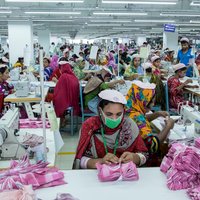Creating a socially fair circular economy in the apparel industry
The concept of the circular economy is entering the mainstream. But a circular economy isn’t just about materials and resources, it’s about people too. We need to show now, more than ever, that the transition to a circular apparel industry can be inclusive and fair.
Our new Request For Proposals for implementation initiatives or research programmes is a first step to making this happen and will help us build a practical and accessible body of knowledge about how these new business models can operate and speed up the transition to an industry that improves the lives and livelihoods of everyone it touches.
Inspiring innovation and learning from mistakes
Creative and circular business models are already emerging within the fashion industry, so we must act fast and proactively. Clothing rental services, reselling used clothes and recycling of materials are just a few that are becoming more common. These new business models are fundamental for the systemic change of the industry and a move away from using scarce virgin resources, and causing damage to the environment. Yet, I was surprised to see that there is not much discourse about the actual or potential social effects of circular economy in the apparel industry.
With the different models of production and consumption comes the need for solution providers – for example to list, collect, launder, sort and repair clothes – increasing and diversifying the numbers and types of buyers and suppliers in the industry. Nearshoring, automation, and the change in skills needed in retail could result in a change or displacement of jobs between industries or regions. How can we proactively mitigate the risks associated with the transition to circular, and also design in the best quality and safest products, working conditions and consumer services possible?
We have unfortunately seen cases where the implementation of new business models have prioritised economic benefits and ignored the human cost. The sharing economy, for example, in transportation, accommodation or delivery services, utilise the previously unused capacity of resources to avoid waste and loss of economic value. However, the flexibility needed in these models has meant that labour has also become flexible resulting in an increase of casual workers on short-term contracts with little to no employee benefits, disproportionately affecting the most vulnerable. This is just one example of how people are impacted by a new business model.
We have an opportunity now to tackle the deep and complex challenges facing the fashion industry by establishing best practice in a new circular economic system. We should ensure that the narrative of circular fashion includes fair treatment of people, decent jobs, promotion of gender-inclusive norms, distribution of power and wealth and companies accountable for all of these. Key enablers of the circular economy, such as collaboration within a fragmented apparel industry, and changed incentive structures can start to do this.
Leading by example
We believe that to fundamentally transform fashion into a force for good, an important element of our “social” lens is addressing gender injustice. Therefore, we’ve been working with BSR on applying a gender and social lens on our circular fashion work. BSR’s expertise in women’s empowerment, consumer goods and the circular economy are helping us identify where our circular fashion partners can take action to enable better outcomes for women and marginalised groups.
Fashion can only be truly circular if it is inclusive and striving for fairer outcomes for all, especially the most disadvantaged groups of society. Companies and enabling organizations working in this space must ensure that impact on and opportunities for people are part of the key priorities from the start. Ensuring a just transition from linear to circular is not an option, it is critical to make sustainable fashion a reality
- Magali Barraja and Cliodhnagh Conlon, BSR
Further to this, in 2018, we set up a group called Bridging the Gap to help bridge the implementation gap between the knowledge of and willingness to adopt circular models and concrete action to redesign businesses towards circularity.
The group brings together four initiatives to inspire and activate fashion industry players in accelerating the implementation of circular business models with clear positive outcomes. One of these initiatives – the WRI/WRAP Clothing Reuse Market Makers - aims to demonstrate the market demand for clothing reuse models in over 20 major apparel brands in the USA, UK and India.
One of its core objectives is to set a framework and robust metrics to measure the environmental and social impact of circular business models to be able to guide companies in decision making and performance measurement when operating clothing reuse services. If you would like to find out more about WRI/WRAP’s work, please contact Deborah Drew, Associate at World Resources Institute: ddrew@wri.org.
With this request for proposals, we hope to find further initiatives and organizations that will enable a new circular system in the apparel industry to be fair and inclusive.
If you would like to apply for a grant under the Request for Proposals, please click here. The deadline for concept notes is 30 July 2019.



